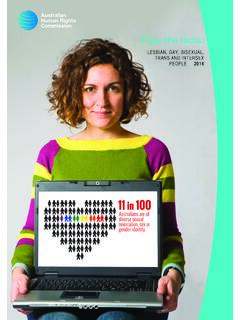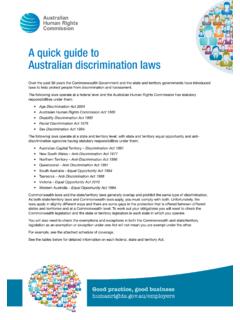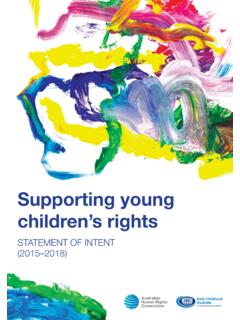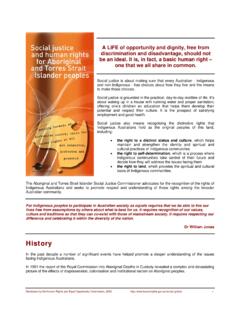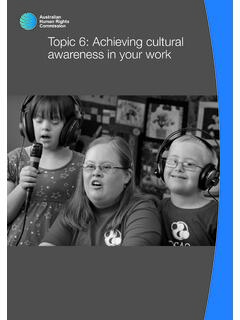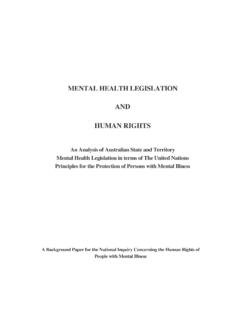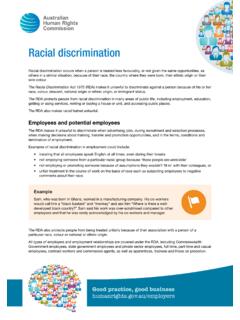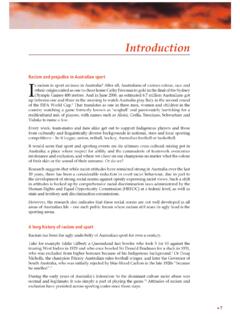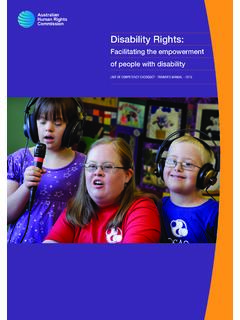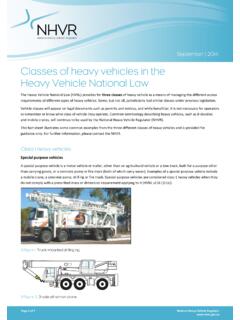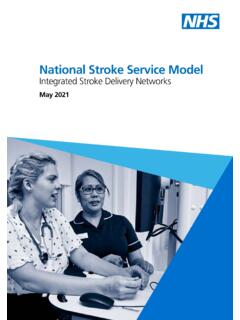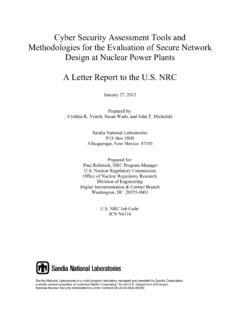Transcription of National Principles for Child Safe Organisations
1 National Principles for Child Safe OrganisationsThe National Principles for Child Safe Organisations have been finalised following sector wide consultation from 2017 learn more about the National Principles for Child Safe Organisations please visit or contact 2 | National Principles for Child Safe OrganisationsPreambleAustralia ratified the United Nations Convention on the Rights of the Child (CRC) in 1990. Under the Convention, children and young people, like adults, possess human rights. They also have the right to special protection because of their vulnerability to exploitation and abuse. Under the Convention, a Child is defined as every human being below eighteen years of age. A wide range of Organisations work with children and young people throughout Australia. These may be small and community based, such as a sports club or playgroup where families and community members contribute voluntarily, through to more highly organised structures like schools, hospitals and churches.
2 These may also be businesses or Organisations employing staff and/or volunteers providing services to and working with children and young people, and which may work across state 2013 the Australian Government authorised a Royal Commission into Institutional Responses to Child Sexual Abuse in response to community concern about widespread reports of cases where Australian institutions failed to protect children from sexual abuse. The work of this Commission has emphasised that members of the public, children and young people, parents, carers, families and communities should be confident that Organisations working with children provide safe environments where children s rights, needs and interests are (date of COAG endorsement) 2018 the Council of Australian Governments (COAG) endorsed the National Principles for Child Safe Organisations (the National Principles ).
3 Drawn from the work of the Royal Commission, Australia s Children s Commissioners and Guardians and the 2005 National Framework for Creating Safe Environments for Children, the National Principles are underpinned by a Child -rights approach to build capacity and to deliver Child safety and wellbeing in Organisations , families and communities. The National Principles , based on the Royal Commission s Child Safe Standards, will drive implementation of a Child safe culture across all sectors providing services to children and young people to ensure the safety and wellbeing of children and young people across Australia. The Principles are high level to allow flexibility in implementation and in recognition of the variety of organisational types, sizes and capacities. The indicators are examples of signposts that an organisation meets the Principles or standards of policy and behaviours.
4 The indicators are provided as a guide only and will vary for different Principles emphasise the importance of culturally safe environments and practices for Aboriginal and Torres Strait Islander children and young people. Aboriginal and Torres Strait Islander families and communities are more likely to access services that are culturally safe and experience better outcomes in such services. This includes improving the way Organisations engage with Aboriginal and Torres Strait Islander children and their families, recognising the impact of intergenerational trauma, and respecting cultural diversity. The adoption and application of National Child safe Principles throughout all relevant sectors across Australia is a significant milestone in promoting Child safety and National Principles collectively show that a Child safe organisation is one that creates a culture, adopts strategies and takes action to promote Child wellbeing and prevent harm to children and young people.
5 A Child safe organisation consciously and systematically: Creates an environment where children s safety and wellbeing is the centre of thought, values and actions. Places emphasis on genuine engagement with and valuing of children Creates conditions that reduce the likelihood of harm to children and young people Creates conditions that increase the likelihood of identifying any harm Responds to any concerns, disclosures, allegations or suspicions of Principles for Child Safe Organisations | 3 Wheel of Child SafetyNational Principles for Child Safe Organisations1. Child safety and wellbeing is embedded in organisational leadership, governance and Children and young people are informed about their rights, participate in decisions affecting them and are taken Families and communities are informed and involved in promoting Child safety and Equity is upheld and diverse needs respected in policy and People working with children and young people are suitable and supported to reflect Child safety and wellbeing values in Processes for complaints and concerns are Child focused.
6 7. Staff and volunteers are equipped with the knowledge, skills and awareness to keep children and young people safe through ongoing education and Physical and online environments promote safety and wellbeing while minimising the opportunity for children and young people to be Implementation of the National Child safe Principles is regularly reviewed and Policies and procedures document how the organisation is safe for children and young only - Signature page for COAG endorsement The Parties have confirmed their commitment to the National Principles for Child Safe Organisations as follows:Signed for and on behalf ofthe Commonwealth of Australia byPrime Minister of AustraliaSigned for and on behalf ofthe State of New South Wales byPremier of New South Wales Signed for and on behalf ofthe State of Western Australia byPremier of Western Australia Signed for and on behalf ofthe State of Queensland byPremier of Queensland Signed for and on behalf ofthe State of Tasmania byPremier of Tasmania Signed for and on behalf ofthe State of South Australia byPremier of South AustraliaSigned for and on behalf ofthe Australian Capital Territory byChief Minister of ACTS igned for and on behalf ofthe State of Victoria byPremier of Victoria Signed for and on behalf ofthe Northern Territory byChief Minister of NT Principle1 Child safety and wellbeing is embedded in organisational leadership.
7 Governance and principle provides guidance on the role of organisational leadership and governance in promoting inclusive and welcoming environments for children and young people, a culture of accountability and the ways in which a Child safe culture is developed and of this principle shows that the organisation has a commitment to Child safety and wellbeing through all levels of the organisation. Governance arrangements are transparent and include a Child safety and wellbeing policy, practice guidance, a Code of Conduct and a risk management framework. Governance arrangements vary depending on the type, nature and size of an organisation. Organisational leadership provides an authorising environment for the sharing of information about risks to children and young people. Key action The organisation makes a public commitment to Child safety.
8 A Child safe culture is championed and modelled at all levels of the organisation from the top down and the bottom Governance arrangements facilitate implementation of the Child safety and wellbeing policy at all levels. A Code of Conduct provides guidelines for staff and volunteers on expected behavioural standards and responsibilities. Risk management strategies focus on preventing, identifying and mitigating risks to children and young people. Staff and volunteers understand their obligations on information sharing and recordkeeping. Indicators that this principle is upheld: The organisation can demonstrate they have publicly available and current documents such as a Child safety and wellbeing policy, practice guidance, information sharing protocols, staff and volunteer codes of conduct and risk management strategies.
9 The organisational leadership models and regularly reinforces attitudes and behaviours that value children and young people and a commitment to Child safety, Child wellbeing and cultural safety. This commitment is clear in duty statements, performance agreements and staff and volunteer review processes. Staff, volunteers, children and young people have a sound knowledge of children s rights, including their rights to feel safe and be heard, and the accountabilities that accompany these rights. Leaders promote sharing good practice and learnings about Child safety and wellbeing. Article 3: All adults should do what is best for children. When adults make decisions, they should think about how their decisions will affect Principles for Child Safe Organisations | 7 Principle2 Children and young people are informed about their rights, participate in decisions affecting them and are taken principle describes an organisational culture that supports children and young people to understand what Child safety and wellbeing means.
10 They are informed about their rights and responsibilities in an age appropriate way. They contribute and actively participate in building an organisational culture that is safe for them. Children and young people know about the organisation s commitment to Child safety and wellbeing and access relevant information and programs. They recognise safe environments and understand protective strategies. In such environments, children and young people feel comfortable participating in decisions and communicating their views and concerns. Ultimately, however, the responsibility for Child safety and wellbeing in an organisation rests with the organisation and its workers. Staff and volunteers value and respect children and young people s identity and culture, are comfortable and skilled in engaging with them, understand their developmental needs and build on children and young people s strengths and capacities.

